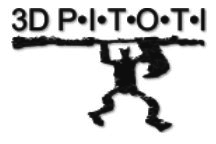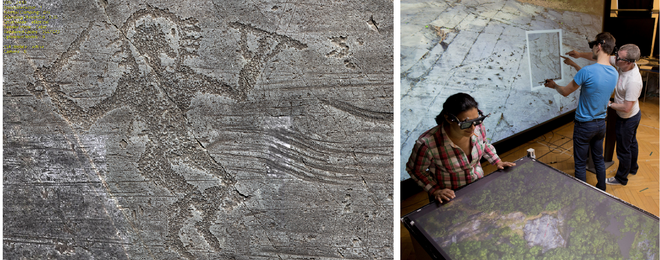The Virtual Reality and Visualization Group is part of many international research project consortia. Please find an overview of past and present projects below.
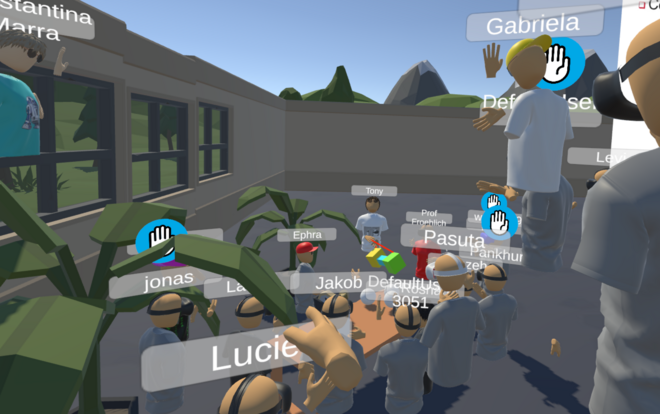
Objective: The Teaching VR in VR project designs, implements and evaluates an immersive module for teaching, learning and testing of VR materials for the Master's course Virtual Reality of the Computer Science department at Bauhaus-Universität Weimar. Teachers demonstrate content to students in live interactive lectures in VR. Students can actively participate in these lectures by trying out VR techniques individually or together. Teaching and learning materials are made available in a persistent social virtual world as interactive VR recordings that can be accessed at any time and from any location. Teaching VR in VR is designed to enhance the experience of the content taught and to increase awareness and understanding of usability issues and limitations.
Teaching Virtual Reality in Virtual Reality is funded by the Thüringer Ministeriums für Wirtschaft, Wissenschaft und Digitale Gesellschaft (TMWDDG) and the Stifterverband.
Duration: 10/2022 - 12/2023
Objective: In diesem Projekt kooperieren die Bauhaus-Universität Weimar (BUW) und die Europa-Universität Viadrina (EUV) mit dem Ziel, ein sozialwissenschaftliches KI-Lab für Forschendes Lernen (SKILL) aufzubauen. Studierende werden hier in den Prozess der Entwicklung und der Anwendung KI-basierter Technologien eingebunden. Diese Technologien werden in der Lage sein, die Struktur von Argumentationen in wissenschaftlichen Artikeln und politischen Arenen zu erkennen, zu analysieren und zu visualisieren und den Studierenden Erkenntnisse für die eigene universitäre Arbeit zur Verfügung zu stellen.
Das Projekt realisiert damit eine neue Qualität von Lern- und Lehrunterstützung für diskursive Analysen. Studierende lernen mit Unterstützung von SKILL Techniken des Argumentierens, sie lernen, schneller systematisches Wissen über den Stand einer Debatte zu erlangen, und sie gewinnen ein vertieftes Grundverständnis für die Funktionsweise, den Nutzen und die Grenzen von KI-Technologien.
SKILL wird vom Bundesministerium für Bildung und Forschung (BMBF) finanziert.
Duration: 12/2021 - 11/2025
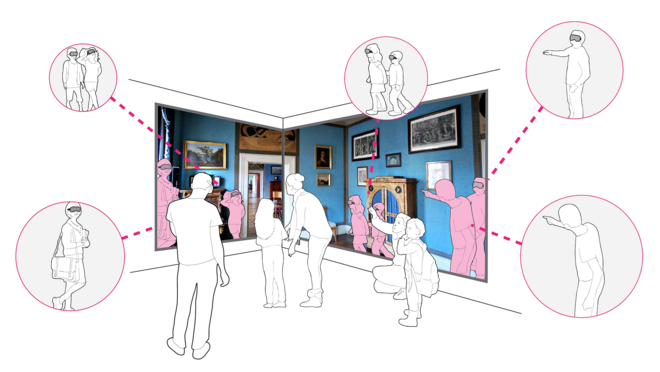
Objective: Im Rahmen des Verbundprojekts Goethe Live 3D werden immersive Lösungen zur Kultur- und Wissensvermittlung bei Museumserlebnissen entwickelt, umgesetzt und evaluiert. Das Goethe Nationalmuseum Weimar dient hierfür als Fokuspunkt für die Anforderungsanalyse, Anwendungsentwicklung und Evaluation. Unsere Projektergebnisse sollen in einer öffentlich zugänglichen Ausstellung vor Ort und ortsunabhängig in einer digitalen Museumskopie gemeinsam und zeitgleich für lokale und nicht-lokale Besuchsgruppen erlebbar sein.
Das Verbundprojekt wird vom Bundesministerium für Bildung und Forschung (BMBF) finanziert und unter der Koordination der Weimarer Virtual Reality and Visualization Research Group mit den Partnern Universität Hamburg, Klassik Stiftung Weimar, ArcTron 3D GmbH, Curvature Games GmbH und Consensive GmbH umgesetzt.
Weitere Information sind auf der Projektwebseite zu finden.
Duration: 07/2021 - 06/2024
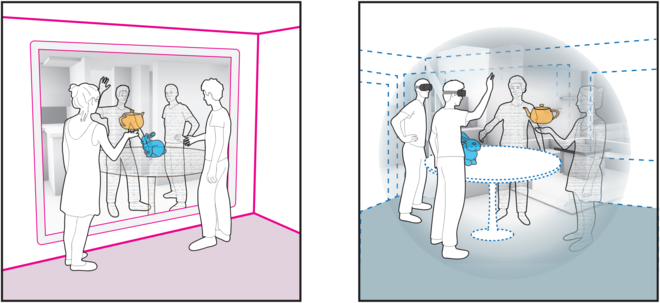
Objective: The APlausE-MR project investigates the plausibility of communication in virtual environments (VEs), focusing specifically on multi-party mixed reality scenarios involving groups of collocated and remote users. The project strives to identify factors that create and maintain plausibility, in order to apply this knowledge to the design of future VEs, and to test the hypothesis that such factors can compensate for each other in a multi-modal setting. To this end, we are developing a distributed VE that supports gestural communication by representing users as abstract and volumetric avatars, as well as supporting high-fidelity audio communication through binaural auralization of sound sources.
The APlausE-MR project is a collaboration with audio and communication experts at TU Ilmenau, and is part of the AUDICTIVE initiative.
Duration: 04/2021 - 03/2024
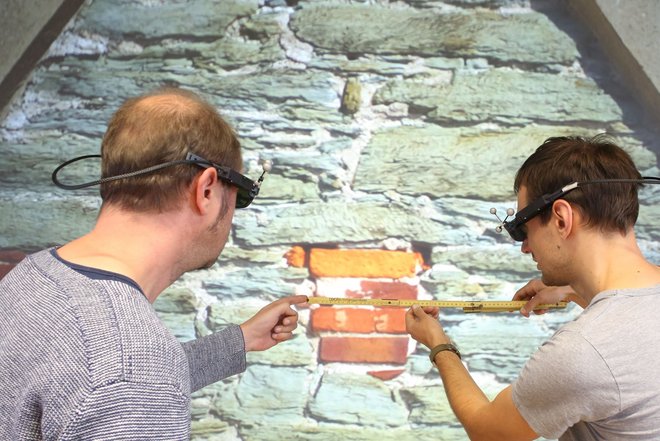
Objective: Das Prioritätsvorhaben „Grundlagen der Digitalisierung in Denkmalpflege und Sanierung“ dient der Erschließung und Vermittlung innovativer Technologien für eine kontinuierliche digitale Bestands- und Zustandserfassung historischer Bauwerke sowie effektiver neuer Werkzeuge für die Bauwerkserhaltung und Sanierungsplanung. Darüber hinaus sollen Möglichkeiten und Synergieeffekte einer offenen Nutzung von 3D-Bauwerksmodellen als gemeinsame Plattform für die Planung und Umsetzung digitaler Innovationen in angrenzenden Bereichen der regionalen Bildung sowie des Kultur-und Tourismusmarketings untersucht werden. Extended Description
Duration: 06/2020 - 08/2021
Links: https://www.vogtlandpioniere.de/ausschreibungen-projekte/projekte/
MetaReal: Immersiver Wissenszugang, kollaborative Exploration und intelligentes Retrieval in einer digitalen Weltkopie
Objective: Mit MetaReal verfolgen wir die Vision, den Zugang zum Wissen durch den Einsatz von fortgeschrittenen Technologien der Virtual und Augmented Reality (VR, AR) sowie der Künstlichen Intelligenz (KI) auf die nächste Stufe zu heben. Wir werden Vorgehensweisen, Verfahren und Interfaces erforschen und entwickeln, um detaillierte digitale 3D-Modelle der realen Welt mit den im Internet vorhandenen komplexen Wissensbeständen anzureichern und für Personengruppen in VR- und AR-Umgebungen natürlichsprachlich im räumlichen Kontext erschließbar zu machen: An die Stelle der isolierten Interaktion mit Bild-schirmen tritt eine immersive und kollektive Erfahrung im virtuellen Raum in einer Art begehbarer Wikipedia, bei der Wissen durch körperliche Bewegungen und sprachliche Äußerungen abgerufen und angeeignet werden kann.
Duration: 01/2020 - 06/2024
Collaborative Visual Analytics on Multitouch-Displays
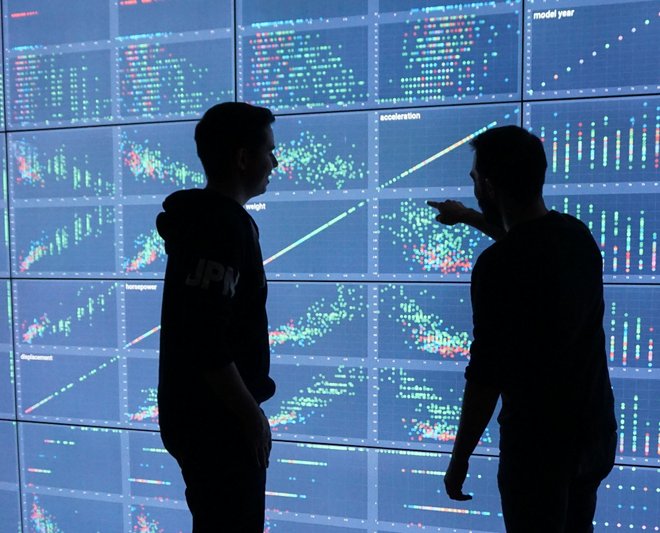
Objective: Today, touch interaction is very common and especially smartphones have established it in everyday life. Yet, visual analytics still almost exclusively relies on desktop setups controlled with mouse and keyboard. This project aims to make collaborative visual analytics processes more effective by developing innovative multitouch interaction methods. Such a system will allow multiple analysts to explore and gain insights into data. In particular the massive amounts of data that are collected during Earth observation pose a challenge and often rely on multiple linked views that visualize different aspects of the data at once. Consistent multitouch interactions for visualizations on large, high-resolution displays will eventually put the users at the center of visual analysis and the data at their finger tips.
This project is a cooperation with the Visual Analytics group at the Institute of Data Science of the German Aerospace Center (DLR).
Duration: 05/2019 - 04/2022
ISBAU
Virtuelle Baugrube: Intelligente Steuerung von Baumaschinen und realistisches Training (ISBau)
Projektziele: Ziel des KMU-innovativ Projekts Virtuelle Baugrube (ISBau) ist die Entwicklung neuer Kommunikations- und Interaktionstechnologien für die Fernüberwachung und die verteilte Steuerung von Baumaschinen. Am Beispiel von Telematikschnittstellen für Saugbagger werden die Anforderungen und Möglichkeiten zu deren intelligenten Steuerung in Zusammenarbeit mit ortsfernen Experten evaluiert. Dies umfasst den direkten Austausch über die Situation vor Ort durch Telepräsenztechnologien. Dazu wird eine Bausituation in Echtzeit dreidimensional aufgezeichnet, mit Plänen der Maschine und Sensordaten angereichert und als gemeinsame virtuelle Realität nutzbar gemacht. 4D-Aufzeichnungen dieser Situationen und Prozessen bieten auch realistische Trainingsmöglichkeiten für die Ausbildung. Extended Description
Duration: 01/2019 - 12/2020
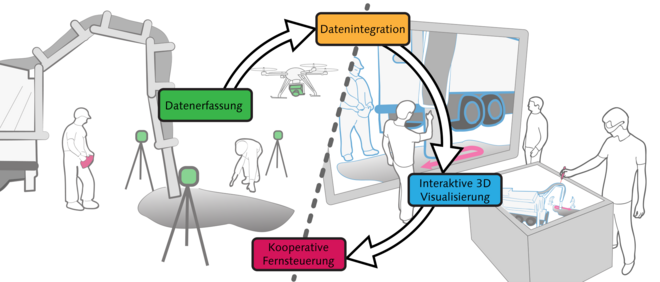
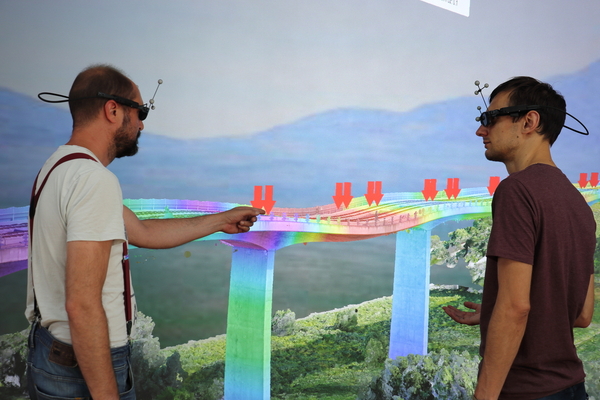
Objective: Das Kooperationsprojekt AISTEC widmet sich innovativen digitalen Methoden zur Überwachung von Strukturbauwerken, insbesondere Brücken. Ziel ist die Entwicklung einer digitalen Prozesskette von der automatisierten Datenerfassung mit unbemannten Flugsystemen über die Modellbildung und semiautomatische Analyse bis zur Tragwerkssimulation und visuellen Prüfung in kollaborativer virtueller Realität. Durch die neuen Methoden kann der Zustand von Brücken und anderer Infrastruktur einfach, kostengünstiger und häufiger überwacht werden.
Duration: 09/2018 - 08/2021
Objective: The Human Brain Project is an interdisciplinary European research project, in which scientists from neuroscience, medicine, physics and computer science work together to simulate the human brain in the computer. In the Neurorobotics subproject, the simulated brain models are connected to robots in order to investigate how the brains react to and deal with stimuli and to develop brain-inspired robot controls. Immersive virtual reality enables the realistic and plausible experience of simulated virtual robots and environments and offers important advantages for the observation, understanding and participation in virtual neurorobotics simulations.
Duration: 04/2016 - 03/2020
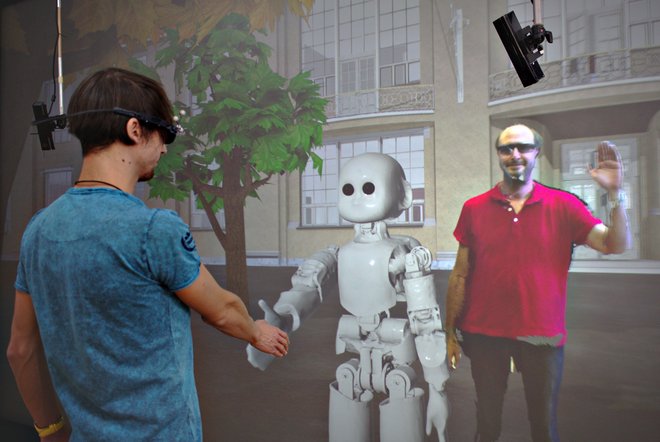
Objective: Data analysis techniques in the age of Big Data are becoming increasingly complex and combine a variety of intelligent technologies. Although the outcomes and results of data analyis are impressive, they are generally difficult to be reproduced and understood by users. Visualization is a first step towards presenting results in a comprehensible manner. However, the underlying motivation, the origin of the data, the transformation processes and the insights gained in the process remain hidden. The objective of the project is to make these processes more transparent to the users.
Duration: 12/2016 - 10/2019

A research building recommended by the German Wissenschaftsrat, DFG and the state of Thuringia, funded by the federal government and the state of Thuringia.
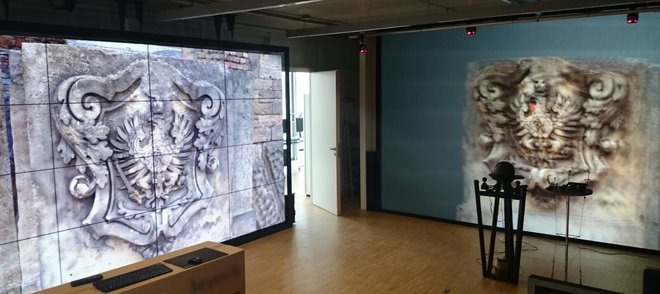
Objective: The junior research group Big Data Analytics is focusing on scalable data analysis and mining techniques and their interplay with research fields like visualization, retrieval and algorithm engineering. Tools and algorithms to support analytic processes in big data will be developed in cooperation with experts from diverse application areas.
Duration: 11/2013 - 10/2018
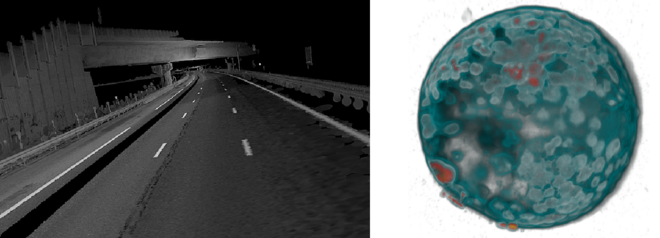
Objective: VR-HYPERSPACE (AAT-285681) was an ambitious project funded under the European Commission’s Seventh Framework Aeronautics and Air Transport (AAT) programme. Begun in October 2011, this project consisted of 9 internationally leading universities, research institutes and industrial partners from 6 European countries. The project ended in September 2014. Adopting radical approaches using virtual reality and mixed reality technologies, and the latest studies in neuroscience and psychology, we are carrying out fundamental research and development leading to a paradigm shift in relation to passenger comfort.
Duration: 10/2011 - 09/2014
Objective: Strategies for the robust design of structures.
Duration: 2009 - 2011

Objective: Virtual environments hold the promise to provide a shared space in which such collaborative interactions of multiple users with virtual 3D models could occur as easily and smoothly as they would in the real world. Large projection-based stereoscopic displays are the most successful incarnation of such immersive virtual environments. These systems use a fixed view point or track the head position of a single user and compute a stereoscopic image pair for that point of view. Unfortunately, when non-tracked users see these images, the virtual environment may appear severely distorted and it changes shape when users are moving.The project IMVIS will carry out research to develop novel projection-based stereoscopic multi-view systems for co-located collaborative 3D displays for multiple users.
Duration: 01/2008 - 06/2011
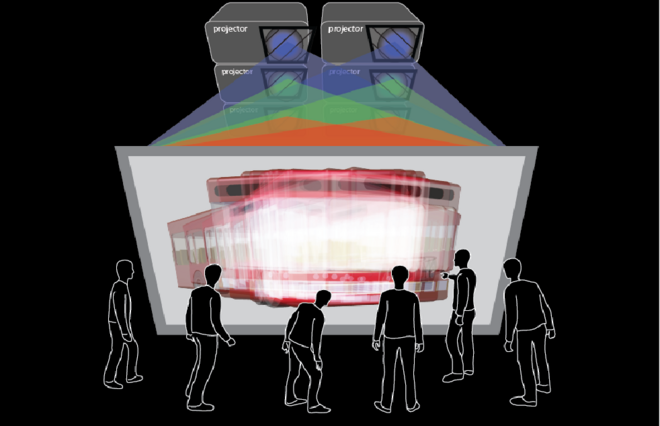
Objective: Innovative information technology for knowledge management.
Duration: 2007 - 2012


